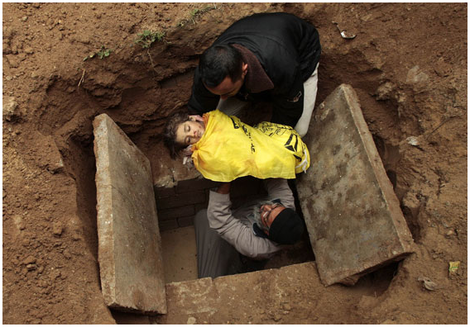
Mohammed Salem (Reuters, from The Guardian), 30 December: Palestinians bury the body of four-year-old Lama Hamdan at the Beit Hanoun cemetery in the northern Gaza Strip
__________________
Mike (Thanks to Stan)

Mohammed Salem (Reuters, from The Guardian), 30 December: Palestinians bury the body of four-year-old Lama Hamdan at the Beit Hanoun cemetery in the northern Gaza Strip
__________________
Mike (Thanks to Stan)
Posted on Thursday, 01 January 2009 at 02:01 AM in Random Excellence | Permalink | Comments (28) | TrackBack (0)
Posted on Thursday, 01 January 2009 at 02:00 AM in Random Excellence | Permalink | Comments (5) | TrackBack (0)
Casper Hedberg, From the story "Violence in Kenya," via VervePhoto.
Born in 1983, Casper Hedberg grew up in a small village in the southern part of Sweden. By the age of 14 he took a darkroom class and got hooked on photography. Casper's professional career started in 2005 when he began working as a full time photographer. A year later he got his Bachelor of Photojournalism at Mid Sweden University in Sundsvall. Today he lives in Stockholm and does assignments for major Swedish newspapers and magazines both in Sweden and abroad. Most of all Casper enjoys reporting about social issues around the world.
_________________________
Mike (Thanks t0 Charlie Didrickson)
Help support T.O.P.!
Amazon U.S. link
Amazon U.K. link
Amazon Germany link
Amazon Canada link
B&H Photo link
Adorama Camera link
Featured Comment by jchristian: "Wow, I keep coming back to this shot. There's so much motion, and it's disorienting & a bit frightening. Love it."
Posted on Thursday, 27 November 2008 at 10:38 AM in Random Excellence | Permalink | Comments (2) | TrackBack (0)
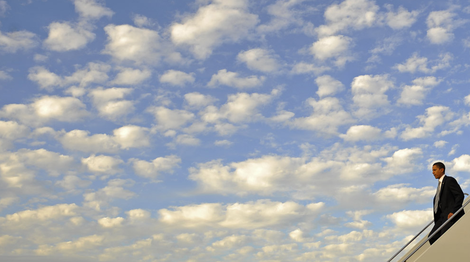
Emmanuel Dunand, U.S. Democratic presidential candidate Illinois
Senator Barack Obama disembarks from his campaign plane at Midway
airport in Chicago, Illinois, October 19, 2008 (AFP/Getty Images).
-
Few extended events are covered as thoroughly as U.S. Presidential campaigns, as news organizations from all over the world ask photojournalists to come back with unique and expressive photographs from heavily covered, repetitive opportunities. Boston.com has gathered 35 of the best photographs of President-Elect Barack Obama from the campaign of 2008.
The photographers in this set are Jim Young, Chris Carlson, Emmanuel Dunand, Alex Brandon, Stan Honda, Jae C. Hong, Doug Mills, Jason Reed, Yoon S. Byun, Joe Raedle, Jeff Fusco, and Pouya Dianat.
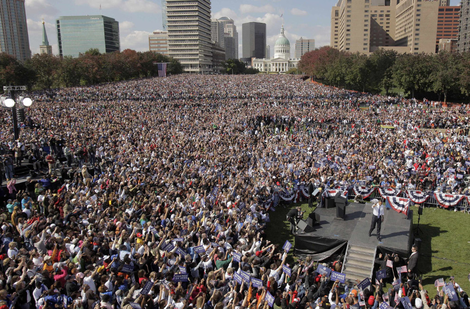
Jae C. Hong, Democratic presidential candidate, Sen. Barack
Obama (lower right) waves as he arrives at a rally of 100,000
supporters in St. Louis, Mo., Saturday, Oct. 18, 2008 (AP Photo).
______________________
Mike (Thanks to Adam McA.)
Featured Comment by Bill Bresler: "Nice gallery. I've photographed nearly every presidential candidate since Ronald Reagan. Every time I've done so, I've had a gut feeling about the candidate. History tells me that I need to listen to my gut. I photographed Barack Obama in early September. If my gut reaction is still accurate, this guy is the real deal.
"Here's my favorite from that campaign rally. I couldn't help but notice these pauses, before he would continue speaking.
"I had the same gut reaction to John McCain in 2000, but eight years later, it was gone."
Posted on Friday, 14 November 2008 at 07:26 AM in Random Excellence | Permalink | Comments (11) | TrackBack (0)
FOR IMMEDIATE RELEASE
Enthusiasts have long enjoyed visiting so-called "bike shows," and many motorcycle shops compete for trophies—not necessarily for speed but for visual appeal. The idea of the motorcycle as art, however, is a more recent conceit, validated by prestigious museums worldwide. The idea of photographing the artists who create this art is new too.
To augment the high-octane popularity of custom motorcycles and Tom Zimberoff’s two best-selling books of the same title, Art of the Chopper is the first comprehensive collection of motorcycles explicitly created as contemporary art and, now, curated for exhibition. Ipso facto, Art of the Chopper
and Art of the Chopper II
(Bulfinch Press) are two of the best-selling photography books in recent years with 130,000 copies in print. The exhibition is further distinguished by its emphasis on the rôles of individual artists.
By integrating Zimberoff's portraits and and documentary photographs of the artists with the actual motorcycles on display, Art of the Chopper offers a glimpse into a parallel universe populated by the high priests of horsepower, lane-splitting libertarians on the road to perdition with a lust for life and a consummate sense of style. It brings to life the legendary persona underlying each artist’s legerdemain with sheet metal, motors, and paint. As indigenous to America as jazz, rock 'n' roll, or the blues, their art balances the polarized dynamics of flamboyance and minimalism on two wheels. What makes them "cool" is getting something wrong just right. They have earned their pinstripes. This is their Hall of Fame.
The exhibition, having premiered at the William J. Clinton Presidential Library & Museum in Little Rock, Arkansas on September 20, will run through February 8, 2009. It then travels to the Appleton Museum of Art in Ocala, Florida, opening February 20, 2009 and running through May 24, 2009.
Choppers/Artists Included: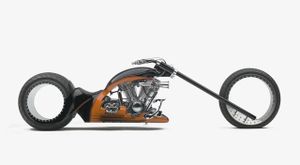
• Holy Roller—Mike Brown
• Unicorn from Hell—Chica
• Cook Norton—Dave Cook
• Psychodelic (intended spelling)—Jerry Covington
• Curves and Redneck Vincent—Vince Doll
• Swingshot—Christian Dotson
• Bettie and Six Pack—Rick Fairless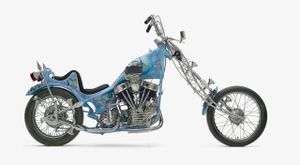
• Odin's Axle—Ron Finch
• Mad Rat—Jerry Graves
• Il Pazzo—Gard Hollinger
• El Guapo—Matt Hotch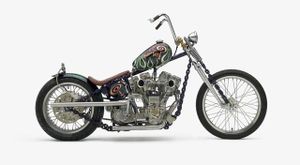
• Chain of Mystery—Indian Larry
• Easyrider—Pat Kennedy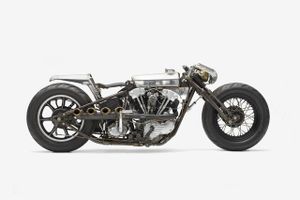
• Spike—Shinya Kimura
• Money Shot—Billy Lane
• Stingray—Scott Long
• Easyriders 30th Anniversary—Mondo
• Untitled (2)—Arlen Ness
• Knuckle Under—Mike Pugliese
• Widowmaker—Kirk Taylor
• El Peligroso—Trevelen
• Camel Three—Eddie Trotta
• Lucky—Greg Westbury
• Suzy-Q—Paul Yaffe
• Flying Pan and Disk Drive—Hank Young
___________________________
Mike
All photos © 2003–2008 by Tom Zimberoff
Featured Comment by Duke: "Zimberoff's reputation as a 'motorcycle photographer' is a relatively new one. You should look further into his career and you'll find a body of work that is without parallel. His works have been displayed from places like England's famed National Portrait Gallery to his most recent show at the Clinton Presidential Library. Name them, Yeager, Lennon, Rooney and now Lane and Indian Larry have all been captured in intimate detail. There are minstrels and troubadours and then there is Tom, writing his silent songs, using only a lens and paper. But if you listen to yourself as you look at his photos, you'll find that a song is playing somewhere in the back of your mind.
"By the way: Don't be mad about the picture of Indian Larry. I happen to know that that was one of his most favorite pictures of himself. He loved doing what he did and he died doing what he loved. He died early but he died well. How many of us will be lucky enough to say that we died that well?"
Posted on Saturday, 08 November 2008 at 01:12 PM in Random Excellence | Permalink | Comments (9) | TrackBack (0)
Explorations of the interstices of life and time can often be moving: thoughtful, reflective. Filled with sadness, longing, realization—and often with love, made visible.
The interface is odd and intrusive—move your mouse to the bottom of the frame to move from one picture to the next—but Phillip Toledano's Days With My Father is a beautiful visual and verbal rumination on the twilight of a life.
____________________
Mike (Thanks to Sean Keane)
Posted on Friday, 24 October 2008 at 11:29 AM in Random Excellence | Permalink | Comments (20) | TrackBack (0)

Markus Spring, Sri Lankan villagers returning to the remains of their village which they had to leave due to combat between army and insurgents two years ago
-
Markus Spring is an official with the City of Munich, Germany. He has made many trips to Sri Lanka as organizer of Munich's assistance to that troubled country. In the framework of a European Commission funded program, he works at capacity-building for water and sanitation in order to improve the living conditions of those the tsunami affected. The program is empowering local government to use modern planning techniques, as well as establishing a well drilling school, and has built numerous wells, rainwater harvesting tanks, and toilets.
In addition to that work at his day job, Markus has been amassing a strong portfolio of photographs dealing with the large number of internally displaced persons in that nation plagued by disasters both natural and human-caused. More at his blog.
____________________
Carl Weese
Posted on Friday, 17 October 2008 at 12:12 AM in Random Excellence | Permalink | Comments (2) | TrackBack (0)
A map of the world on the wall behind it is refracted through a water droplet. Check out the strange and wonderful world of Martin Waugh's Liquid Sculpture.
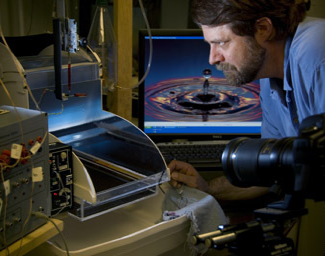
Martin Waugh at work, by Charles Waugh
__________________________
Mike (Thanks to Michael Gottlieb, and Martin)
Posted on Tuesday, 14 October 2008 at 07:47 AM in Random Excellence | Permalink | Comments (6) | TrackBack (0)
From Joshua Lutz's outstanding Meadowlands series. Found through Flak Photo. The Meadowlands are a much-abused ecosystem of wetlands in northeastern New Jersey.
C.f. Guido Castagnoli's photographs of exurban Japan.
_______________________
Mike (Thanks to Eolake)
Featured Comment by robert e: "I found a three-minute YouTube video of the Meadowlands project in which the photographer talks about how the project and vision evolved.
"As far as I'm concerned, Lutz captured something essential and tragic about the Meadowlands. Incoherence and jarring juxtapositions are, in my opinion, salient qualities of this place where abundances of natural beauty and man made ugliness alike seem to coexist in a careless jumble, as if both had been dumped there like so much unwanted trash—chaotically rich yet hopelessly unharmonious.
"The video shows the photos are slightly squarer than 4:3. That and the shallow depth of field have me guessing large format, though maybe not too large.
"And speaking of 'jarring,' is that a corpse toward the end of the flash slideshow?"
Posted on Monday, 06 October 2008 at 09:39 AM in Random Excellence | Permalink | Comments (16) | TrackBack (0)
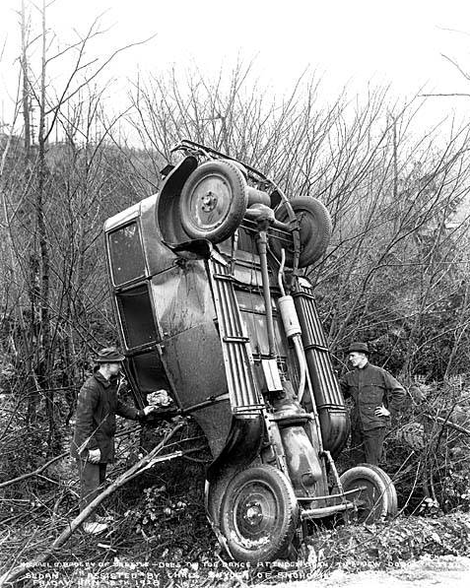
Automobile accident at Index, January 13, 1928
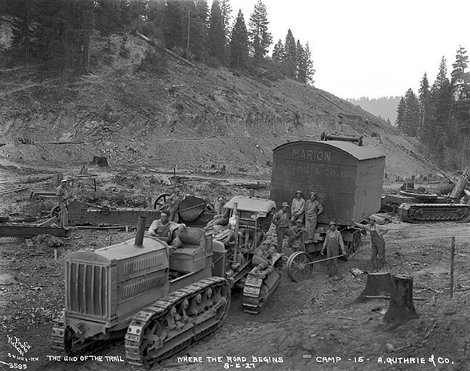
A. Guthrie and Co. equipment, August 5, 1927
I can usually stand but so much reading and writing about gear. After too much of it, the time comes when I have to go take refuge in pictures again. Nothing's quite as bracing as a good historical archive, looking at the work of photographers who often had only one shot to work with and generally had no artistic pretensions because photography—their photography, certainly—wasn't considered art. They often simply photographed things they found interesting, meaningful, unusual, or remarkable.
The University of Washington Libraries Digital Initiatives program has a large selection online from its archives of the work of Lee Pickett, a photographer who worked in Washington State from 1911 until the 1940s. The official photographer of the Great Northern Railway, he was based in Index, Washington, in the heart of the Cascade Mountains.
The writing of titles and notes directly on the negatives is often a tip-off to a working photographer's lack of artistic pretense; it's almost a formal flag of the primacy of the documentary record. (Although photographers got good at writing backwards, they sometimes still slanted their letters forward as they wrote, making the slant look backwards in the print.)
Note the crude but effective posing aids in the picture below (that's one way to make dogs sit still for a picture!). Two of the dogs are looking intently at the man whose foot appears in the right side of the frame. A beautiful photograph, of which any postmodernist could be proud.
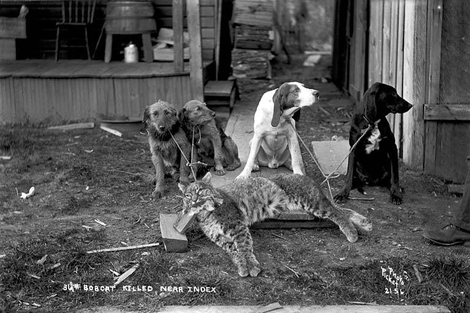
Bobcat killed near Index, no date.
________________________________
Mike
Featured Comment by John Roberts: "'They often simply photographed things they found interesting, meaningful, unusual, or remarkable.' I find this approach to photography many times produces work that is so much more interesting than what is usually offered up as 'art' photography. Perhaps it's the complete lack of pretense that allows photographers like Mr. Pickett to produce photographs that still hold our interest so many decades later."
Featured Comment by John Robison: "When I view photos like these, of a long gone time, I have a question. Who are taking pictures today of the usual, the boring, the record, the mundane, the ebb and flow of "common" things. Photos that will wind up in the main street museums of towns small and large? Seeing these makes me want to grab the largest format camera I have, load it with some 100 iso film, and go make pictures of these very common things."
Mike replies: I've always said that at the very least, cities and states should have official "public photographers" whose job it is to document everyday life, what the city looks like at any given time, simply to leave some tracks and make a record. If it were something that we had started doing a hundred years ago, no one would question it. But since we don't do it, no one sees the point in it. It would amount to the most minuscule drop in the bucket of public expenses, but it would likely provide a meaningful adjunct to the motley of pictures that are taken (and that endure) haphazardly, by artists, amateurs, snapshooters, photojournalists, and for commercial purposes. To answer your question, though, probably the closest thing to what you're talking about are newspaper photographers. Of course, one problem with that is that when newspapers go out of business, often as not their archives are discarded.
Featured Comment by John Camp: "Actually, the place where this gets done, a lot, is not museums but state historical societies. They often buy large collections of genre photos, absorb old newspaper files, and so on. These society files, along with newspaper files, regularly get used to create "Our Town Yesterday" books, which you can find everywhere. I even wrote the introduction to one, called Strange Days, Dangerous Nights, by Larry Millet.

Strange Days, Dangerous Nights
"For people who live near a state capital, the historical societies are photographic treasure-houses, as are (sometimes, depending on the funding mechanism) local county and city historical societies. A pretty famous photo book, Wisconsin Death Trip, came mostly through one of these societies, I think (from Jackson County, Wisconsin).
"While these societies are a wonderful resource for daily photography, one problem is that the photos tend to be 'event' oriented. I think there might be some value to organizing a kind of photo expedition which would simply take 'flat' photos—the interiors of supermarkets and stores and factories, document dress and 'what's in the refrigerator' and medicine cabinets, including close-ups of the contents of medicines and cereals and all the other things we put in our mouths...a kind of uninflected index of our civilization at this point."
Mike adds: Wisconsin Death Trip is a great book, although it's one I've never owned (I thoroughly osmosed the library's copy in art school).
Posted on Saturday, 27 September 2008 at 12:17 PM in Random Excellence | Permalink | Comments (10) | TrackBack (0)
I can't remember when or where I first encountered the work of Hin Chua, a young Australian from Perth, born in Malaysia, now working in London. But his pictures made an impression on me; some of them I remember still, specifically, even though I haven't seen them in several years. (With me that's saying something, because I look at a lot of pictures.) He says he "picked up a camera in an attempt to get over a girl."
I don't know how I ran across him this time, either, but somehow (a Google image search, maybe?), I discovered he has some pictures on flickr. I don't normally care for flickr but I looked at perhaps 600 of the 1350 pictures he has posted there. (I don't know how to link to flickr. Search "Hin Chua" and you should find him more easily than I could.) Naturally with that many pictures not all of them are masterpieces, but he sure has got an eye.
He's gotten more serious about his photography since I encountered him last: better cameras, bigger negs, website. And that's good; he's respecting his talent. I think he has a book out, too (and I'd like to know for sure). He still seems a little immature to me—as an artist, I mean—but maybe that's because the way he sees is young: brilliant, profligate, callow. I certainly don't know if I've picked the best examples to show here. A thousand of us could look at his pictures and come away with a thousand different favorites. You could quarrel with my picks. Propose alternates. (These two are from "After the Fall" and "Mare Nostrum.") I like this photographer better than most, that much I will say.
________________________
Mike
Featured Comment by Curio: "On Shane L.'s site, Chua wrote, 'Flickr functions as an online version of Diane Arbus’ wall. You know the one. the wall covered with work prints, the ones you’re trying to see if you can still bear to look at in a few months time. Except in this case, any man and his dog can wander in. It also just so happens that a few great people whose views I respect also pass through from time to time, and their thoughts, comments and suggestions have really helped shape the work. I have a living room full of work prints, and while it’s a damn nicer sight to look at, it hasn’t been as creatively beneficial as the Flickr version. Flickr (like the world) is what you make of it, and there’s just no way you can tar it with any one brush.' "
Posted on Friday, 26 September 2008 at 09:42 AM in Random Excellence | Permalink | Comments (21) | TrackBack (0)
Introduction: After a previous "Random Excellence" posting, I got into an argument in the comments with two readers who didn't like my choice. At the end of the conversation, I made them an offer: I told each of them that they could pick a "Random Excellence" of their own, and that I would post whatever they chose. One participant (very courteously) begged off, and the other was Bruce Robbins, whose choice—and I agree it's a great one!—is presented here. —Mike
-
By Bruce Robbins
It's a fair bet that many TOP readers would love, given the chance, to make their living from photography. However, anyone who's actually tried selling prints over the web will tell you that it's not an easy thing to do. I remember once emailing a photographer with a great online portfolio to ask him how many prints he'd sold. Back came the message, "To date I have sold zero prints." And that guy's work was superb.
One man who is "living the dream" is New York snapper Dave Beckerman. He's one of the few photographers I've encountered on my travels around the internet who makes his living entirely from print sales. Of course, it helps that he's based in New York: if he'd been born in Duluth, Minnesota, he might have made a few sales but his market would have redefined "niche." It also helps that he's got a great eye, without which the greatest urban environment on the planet would have been of little assistance.
Dave turned his hand to many jobs before settling on photography. His own biography lists screenplay writer, taxi-cab driver, bus-boy, can-carrier in a movie lab, custom color lab printer, programmer, and lighting director on feature films. There are other jobs too boring to own up to. Of his journey to online print sales, he says, "After working as a programmer in the corporate world for ten years—I was propelled one day—or compelled—to try and make a living at photography. Part of what propelled me back into photography (after my programming stint) was the sudden realization that a properly mounted and framed photograph was a finished product; and that there was a good chance that I would get more satisfaction from this bit of art than weeks or years of managing programmers.
"Art existed whether anyone liked it or not. Whether anyone bought it. Whether anyone saw it. No matter. It existed. It was complete. Photographs don't need a committee of producers or vice-presidents to give them the okay. In the beginning, I was very happy to simply show my work to friends, and not try to make a business of it." He's been selling prints on the web since, as he puts it, last century (1999) but, even if he weren't, he'd still be roaming the streets of New York with his Canon DSLR in hand capturing the vagaries of life in the Big Apple and producing his "finished product."
His philosophy about photography is straight to the point: "I don't believe that you need to go to school to learn photography. It is more important to have something interesting to say about life, or if not interesting, funny. When people ask me about where to study photography, I tell them to study literature or music instead."
The photograph above is called "Taste of Snow." I love the timing here. Not only has Dave caught the decisive moment in the girl's attempt to land a snowflake on her tongue but he's also snapped her against the dark hood of the boy in the background. Had this supporting character not been there, the girl's action would have been lost against the light-color taxi in the background. Some might put that down to luck but I know from my own experience that when you're in the zone, photographically speaking, these are the little details you are actually conscious of at the moment of releasing the shutter.
___________________
Bruce
Posted on Saturday, 13 September 2008 at 10:31 AM in Random Excellence | Permalink | Comments (28) | TrackBack (0)
Normally when I post one of these I'm just talking about one picture and not the photographer's entire body of work, but in this case I've just chosen one example more or less at random from the whole portfolio on Mike Mitchell's website, which is called "Lumi-Gnosis." To me the work is better in toto than in isolation. Also, don't miss Mike's infrared portfolio (it's called "Other Lights"). I'm normally nearly allergic to infrared, but I like Mike's. His aren't gimmicky, in some essential way.
Mike Mitchell, from Other Lights
_______________________
Mike (Thanks to Joe Cameron)
Posted on Thursday, 11 September 2008 at 05:46 AM in Random Excellence | Permalink | Comments (8) | TrackBack (0)
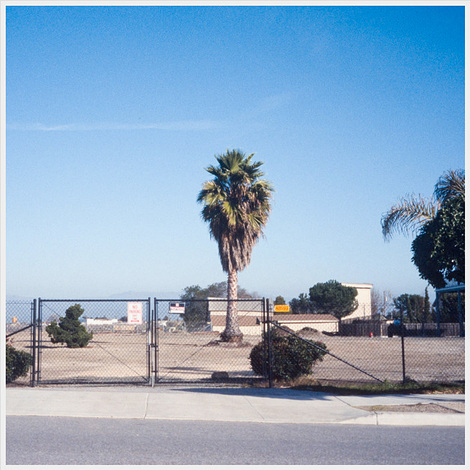
Paul Crovella, Palm Tree
Back in art school when I didn't get enough haircuts and wore my jeans till they fell apart, I used to say my ambition was to take pictures with nothing in them (just being contrary), so you can probably sympathize when I say I love shots like this. It's the "shots like this" part where the mystery lies, however. Twenty years ago—warping into thirty, now, must be—my friend Kim had a legendary radio show on WHFS in Washington, D.C. that centered on new music and unknown bands. Kim is not a man of many or fancy words, but he's wise in the ways of art. He taught me that there's no such thing as "that kind" of art—that within every genre there's the whole gamut, a lot of bad and a lot of average and maybe a little good, too. He'd say he couldn't "hear" music he didn't understand, and he'd listen till he got it. When somebody says something like "I hate abstract expressionism," or "I hate rap," they only mean they've never looked into it and it's still something apart and outside. People who understand, differentiate. They see the landscape of that genre, the ups and downs, the ins and outs. Until you start to get the subtleties, you haven't yet really started to see.
Naturally we only get down to seeing the subtleties of the things we like well enough to look at to begin with. Sympatico precedes affection.
This is a great shot of its kind, I think. On his website, the photographer talks about the "...somewhat humorous sense of isolation of a palm tree on a barren lot behind locked gates." I see what he means, but only because he tells me. I don't read humor. I read this entirely formally. The abstract clumping of the bushes broadcast across the frame, the distinctively different plant centered in the frame standing apart from the pattern, the echo of the slash of sidewalk in that single line in the sky. Those two side-by-side rectangles like frames. Look at the lines, the echoes, the way things touch. Desert sunlight both bright and milky. That one little dab of yellow; if this were a painting, the painter would have stared at his picture for three days, admiring and critical, added that little rectangle, then pronounced his work done.
______________________
Mike
Featured Comment by Robert Roaldi: "This topic about seeing things that the creator didn't intend [being discussed in the comments] is a difficult one. In an interview once, I heard the Canadian author Margaret Atwood say that if the reader spotted something in one of her novels, she'd be happy to take the credit for it (whether she'd intended it or not).
"I looked at that photo and the first thought that came into my mind was 'suburban wasteland.' Was that what the creator intended?
"I don't see how you can ever escape from having viewers (or readers) find things in a work that the creator didn't consciously intend. Points of view are simply too different from each other. I don't think you could ever limit the 'meaning' of a work to only what the creator originally intended either, even if it were possible to strictly determine what that had been. If you asked the photographer what he intended at the moment of creation, and got a coherent answer, that answer might be different from one he might come up with a day later.
"This is a common experience. If you read the same novel several years apart, it's astonishing to see how different the work is the second time round, or third, even though it's the same words.
"The issue is made more difficult by the fact that there is no guarantee that a visual artist is even able to articulate in spoken/written language what it was they were trying to convey. I tend to have a personal prejudice against trying to express verbally what an image is supposed to mean visually."
Featured Comment by John Robison: "The problem is that some of us, like me, are literal-minded. We see what's there, and only what's there. But...if I were to express the first impression that came to my mind it would be HEAT! Hot, unrelenting sun beating down on hot pavement, nowhere to run to cool off, ack, can't breathe, too hot. My feelings about hot weather color everything when I look at this photo."
Posted on Monday, 25 August 2008 at 10:06 PM in Random Excellence | Permalink | Comments (37) | TrackBack (0)
The subject of Miroslav Tichý is so large and replete with ramifications that I almost don't know where to begin; I'm beset by the feeling that he's a transcendent primitive, photography's William Blake.
The artist’s tireless capturing of his immediate environment seems like an attempt to get a grip on a reality from which he has withdrawn and that is now rejecting him in return. In allusion to Plato’s cave allegory, he regards the world as mere reflection and himself as its only conscious observer. (M1M)
-
Miroslav Tichý with two of his homemade cameras
Should the path fascinate, here's a start:
Texts at tichyocean.ch
_______________________
Mike (Thanks to Kathleen and others)
Posted on Friday, 15 August 2008 at 12:31 PM in Random Excellence | Permalink | Comments (23) | TrackBack (0)
A father's snapshot of his 11-year-old daughter successfully executing a bunt in a girls' softball league, taken through the chain-link fence. Chambersburg, Pennsylvania, July 2008.
"I hope you all happened to be watching the Angels-Red Sox game on Monday night when the Angels pulled off the small-ball fait accompli—a perfect suicide squeeze. It was beyond beautiful.
"This is my pal Jenna Burnett executing a bunt a few Sundays ago on a field somewhere in Pennsylvania. Of all her accomplishments I'd rank being able to bunt way up the list." (Bob Burnett)
_____________________
Mike
Featured Comment by Tom K.: "A wonderful slice of Summer and Baseball and Americana itself. I love baseball. I love this photo."
Posted on Thursday, 31 July 2008 at 10:25 AM in Random Excellence | Permalink | Comments (18) | TrackBack (0)
The George Eastman House has just uploaded several new sets on to flickr. Portrait photographers will be interested in the excellent and extensive selection of Southworth & Hawes daguerreotypes, long considered among the early masterpieces of photographic portraiture.
______________________
Mike (Thanks to els)
Featured Comment by Geoff Wittig: "The Eastman House Southworth & Hawes show was a landmark exhibition; there were literally hundreds of images, from delicate tiny locket photos to spectacular 'whole plate' Daguerreotypes of unbelievable quality. They are essentially a first generation contact image, with great detail rendition in larger examples. As others have noted, Daguerreotypes are impossible to reproduce accurately; they are subtle metal-on-metal images with an almost holographic quality, and the appearance changes with the lighting and the viewer's position. I went back to see the exhibition in Rochester repeatedly, just to get a sense in my head of what the images really looked like.
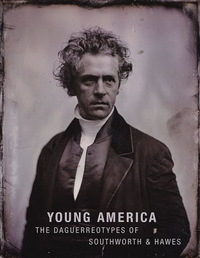 "Southworth & Hawes were sort of like the Yousef Karsh or Annie Leibovitz of their day. Celebrities and politicians from far and wide beat a path to their door for an official portrait. Some of the preachers genuinely look and pose like rock stars. The portraits of icons like Ralph Waldo Emerson are remarkably contemporary.
"Southworth & Hawes were sort of like the Yousef Karsh or Annie Leibovitz of their day. Celebrities and politicians from far and wide beat a path to their door for an official portrait. Some of the preachers genuinely look and pose like rock stars. The portraits of icons like Ralph Waldo Emerson are remarkably contemporary.
"The exhibition's catalogue (Young America: The Daguerreotypes of Southworth and Hawes) is a remarkable effort to reproduce the images. Printed on very glossy stock, it comes as close as you can get to imitating the Daguerreotype effect. It's still available from Amazon, heavily discounted from the original $120 price.
"Many Daguerreotypes were indeed hand-colored after development for a specific artistic effect. The subtleties of the 'plain' images are wonderful, but obviously there was a market for such colorized versions. They have a lot in common pictorially with other crude attempts at colorizing monochrome images."
Posted on Sunday, 27 July 2008 at 07:15 PM in Random Excellence | Permalink | Comments (13) | TrackBack (0)
Lee Friedlander with his Hassy Superwide, by Richard Avedon. (No special reason, just ran across this.)
__________________________
Mike
Featured Comment by John Mitchell: "Another Random Excellence: Avedon by Friedlander, made on the same occasion. See Jeffrey Fraenkel's article "One Day in May," Aperture magazine No. 188, Fall 2007."
Posted on Monday, 21 July 2008 at 07:20 AM in Random Excellence | Permalink | Comments (8) | TrackBack (0)
"Since 2005 nearly the only camera I’ve used is a cheap toy camera—the Holga. With a plastic lens, single aperture, and guessed focusing,
I produce pictures that hope to triumph over these limitations.
Whenever I’m asked why I take pictures with a cheap plastic camera I
find myself giving an answer something along the lines of, ‘Well,
aesthetically I’m conceptualizing an alternative to the dominant form
of image capture vis-à-vis the digital realm.' The reality is closer to
‘I don’t know,’ but the answer likely to be somewhere around the same
reasons that people fix up old cars, brew their own beer or play the
ukulele. It’s low art with outsized dreams. For my purposes I busy
myself with the simple practice of looking at the real world, imagining
it as a photograph, applying the craft of photography, and delighting
in what comes of that. Simple pleasures."
- —Robert Holmgren
Toy Camera Dreams: Photos by Robert Holmgren and Joe Reifer
Lucky Juju Pinball Art Gallery—August 1–31, 2008
713 Santa Clara Ave, Alameda, CA [Map]
Opening Friday, August, 1st from 7–10 p.m.
The art show is free; play pinball between 6 p.m. and midnight for $10
__________________________
Mike (Thanks to Joe)
Posted on Tuesday, 15 July 2008 at 11:18 AM in Random Excellence | Permalink | Comments (23) | TrackBack (0)
From the series "Paul & Joe," by Benjamin Kanarek, which he says he shot with "one of my three Pentax K20D's." A 12-picture spread and the cover image will be featured in the next issue of Spring magazine (Paris) and will be featured at the next International Festival of Fashion Photography in Cannes, France. Ben is a Canadian who lives in Paris.
_____________________
Mike (Thanks to Benjamin)
Posted on Wednesday, 18 June 2008 at 08:43 AM in Random Excellence | Permalink | Comments (16) | TrackBack (0)


